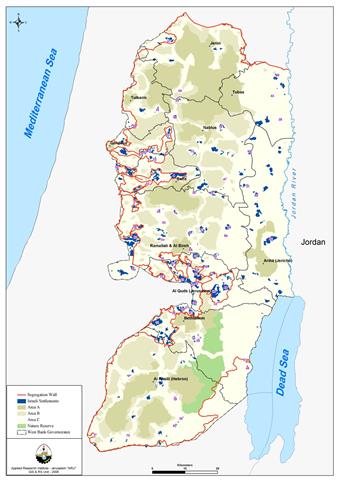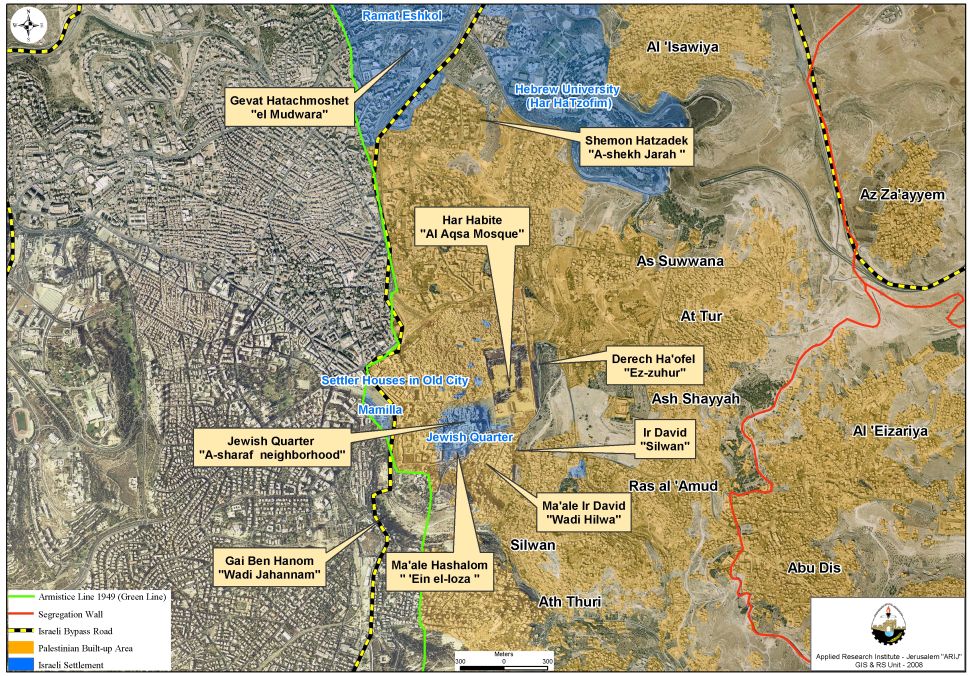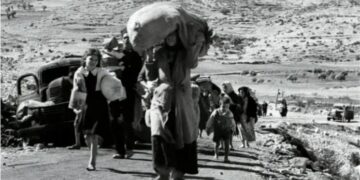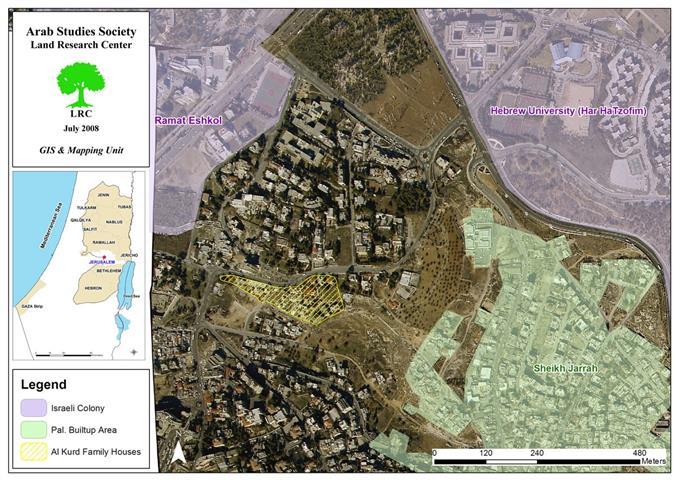When Israel occupied the West Bank including East Jerusalem and the Gaza Strip in the aftermath of the 1967 war; it started with procedures to redefine the Arabic names of the occupied Palestinian areas to use alternative Hebrew names. This was done by “The Government Names Committee”, which is oneof the Israeli Prime Minster's office divisions, and is the governmental body which took responsibility for making these changes.
For the purpose of giving legitimacy to the existence of Israel in the Occupied Palestinian territory following the 1967 war, Israel changed the West Bank name into what the Israeli call “Judea and Samaria”, and the Gaza strip into “Gaza area”. Israel also changed the names of many places within the West Bank territory for the sake of Jewish settlers and gave religious dimension to their existence in fact to the occupation, especially in East Jerusalem. The overall goal behind these changes is to write-off the Palestinian memory and dissociate Palestinians from their heritage, history and foremost their land as was clear in the Israeli Foreign Minister Tzevie levnie who asked Palestinians to delete the term 'Al Nakba' from their dictionary, as a condition to continue the peace process and to declare the Palestinian state.
Israeli Settlements in the West Bank
Israel deliberately changed the names of the Arab areas in the West Bank and renamed them by ancient Canaanite names, and claimed that these names are Talmudic and Hebrew names. Today there are about 199 settlements in the West Bank and more than 200 outposts named by Hebrew names or names related to the Torah and the Jewish history. It must be pointed out that the number of names of places that were mentioned in the Torah is only 150 names. The question is 'how did the 150 names were amplified to more than 400?', the answer is that the settlements' leaders and The Government Names Committee found that the symbolic role of place-names as expressions of ideological values has become a powerful tool for reinforcing the national Zionist ideologies. In this context, Biblical and Talmudic place names were reintroduced to reinforce the bonds between the Jewish nation in Israel and the land of Palestine Table 1, lists some 150 Israeli settlements that were established on confiscated Palestinian lands and were given Hebrew names instead of their original Arabic names.
|
1 |
Settlement name |
Arabic name |
District |
|
2 |
Adora |
Doura – Tarqumia |
Hebron |
|
3 |
Almog |
El- mukalak |
Jericho |
|
4 |
Almon ( Anatot ) |
Hizma |
Jerusalem |
|
5 |
Ariel |
Eskaka |
Salfit |
|
6 |
Atarot |
Beit Iksa |
Jerusalem |
|
7 |
Ateret |
Atara |
Ramallah |
|
8 |
Barqan |
El- Buraq |
Salfit |
|
9 |
Beit Arye |
Umm Safa |
Ramallah |
|
10 |
Beit El |
Beitin |
Ramallah |
|
11 |
Beit Horon |
Beit Or el – foqa |
Ramallah |
|
12 |
Betar 'Illit |
El- Jami / Wadi Fokin |
Bethlehem |
|
13 |
Bruchin |
Burqin |
Salfit |
|
14 |
Dolev |
El-janiya |
Ramallah |
|
15 |
East Talpiot |
Sur Baher |
Jerusalem |
|
16 |
Elon Moreh |
Rojb/ Azammut |
Nablus |
|
17 |
Enav |
Enaba |
Tulkarm |
|
18 |
Eshkolot |
Hamama |
Hebron |
|
19 |
Geva Benjamin (Adam) |
Jaba' |
Jerusalem |
|
20 |
Gilo |
Beit Jala / wadi Ahmad |
Bethlehem |
|
21 |
Ginnot Shomeron |
Bidya |
Salfit |
|
22 |
Giva't Ha-Matos |
Tabbaliya |
Bethlehem |
|
23 |
Giva't Shappira |
El -eisawiya |
Jerusalem |
|
24 |
Giv'at Ze'ev |
El-Jib |
Jerusalem |
|
25 |
Hallamish |
wadi el asmar / en-nabi saleh |
Ramallah |
|
26 |
Har Adar (Giv'at HaRadar) |
Tal el raddar |
Jerusalem |
|
27 |
Har Gilo |
Beit Jala |
Bethlehem |
|
28 |
Har Homa |
Abu Ghnaim |
Bethlehem |
|
29 |
Hemdat |
Tubas |
Tubas |
|
30 |
Homesh |
Silat Ezaher |
Nablus |
|
31 |
Karmel |
El – Karmel |
Hebron |
|
32 |
Karne Shomron |
Kafr Laqif / Jinsafut |
Qalqiliya |
|
33 |
Kedar (Old Kedar) |
Wadi el qudeira |
Jerusalem |
|
34 |
Kedumim |
Kafr Qaddum |
Qalqiliya |
|
35 |
Kokhav HaShahar |
Deir Jarir |
Ramallah |
|
36 |
Kokhav Ya'acov |
Kafr Aqab |
Jerusalem |
|
37 |
Ma'ale Adummim |
Abu Dis / El-khan el ahmar |
Jerusalem |
|
38 |
Ma'ale Efrayim |
Duma |
Jericho |
|
39 |
Ma'ale Hever (Pene Hever) |
Bani Naim |
Hebron |
|
40 |
Ma'ale Levona |
Al -lepan |
Ramallah |
|
41 |
Ma'ale Mikhmas |
Mikhmas |
Ramallah |
|
42 |
Ma'ale Shomron |
Jinsafut |
Qalqiliya |
|
43 |
Ma'on |
Ma'in |
Hebron |
|
44 |
Maskiyyot |
Um el-Darajat |
Tubas |
|
45 |
Mehola |
Bardala |
Tubas |
|
46 |
Mekhora |
Beit Dajan |
Nablus |
|
47 |
Mevo Horon |
Yalu |
Ramallah |
|
48 |
Migdalim |
Majdal Bani Fadil |
Nablus |
|
49 |
Mishr Adummim |
El-khan el ahmar |
Jerusalem |
|
50 |
Mizpe Shalem |
El – Himar |
Bethlehem |
|
51 |
Mod'in Illit (Qiryat Sefer) |
el- Midya/ Ni'lin / Bel'in /Deir Qaddis |
Ramallah |
|
52 |
Mshoki Dargot |
Um el-Darajat |
Bethlehem |
|
53 |
Nahl'iel |
Haq el-Matamir |
Ramallah |
|
54 |
Neve Ya'akov |
Beit Hanina |
Jerusalem |
|
55 |
Nili |
Ni'lin |
Ramallah |
|
56 |
Nokdim |
Shuqeib |
Bethlehem |
|
57 |
No'omi (Na'ama) |
Nu'ema |
Jericho |
|
58 |
Ofra |
Ein Yabrud |
Ramallah |
|
59 |
Oranit |
Abu – el ja |
Qalqiliya |
|
60 |
Pesagot |
Jabal At- taweel |
Ramallah |
|
61 |
Peza'el (Fezael) |
Fasayel |
Jericho |
|
62 |
Pisgat Ze'ev |
Hizma |
Jerusalem |
|
63 |
Ramat Eshkol |
Et-Tufahha / Umm el -Amud |
Jerusalem |
|
64 |
Ramot |
El-Tuleilya |
Jerusalem |
|
65 |
Rimmonim |
Rammon |
Ramallah |
|
66 |
Sa Nur |
Ajja |
Jenin |
|
67 |
Sal'it |
Abu -Urqan/ Kafr sur |
Tulkarm |
|
68 |
Shaked |
wadi abu – Loza |
Jenin |
|
69 |
Shavei Shomron |
Deir Sharaf / Zwata/ Sabastya |
Nablus |
|
70 |
Shilo |
Wadi abu- lajja/ Silon |
Nablus |
|
71 |
Shim'a |
Shama |
Hebron |
|
72 |
Tekoa |
Taqu' |
Bethlehem |
|
73 |
Yakir |
Haris / Kifil Harith |
Salfit |
|
74 |
Yizhar |
Burin |
Nablus |
For the full list check: Geographic sites in Palestine: Arabic names
and Hebrew Denominations; Shukry Arraf
Map 1: Israeli settlements established on confiscated Palestinian lands and were given Hebrew names.
Judaization of Jerusalem
The Judaization plan for Jerusalem city was implemented immediately after the Israeli occupation of the Palestinian territory in 1967. It should be clear that the Judaization process of Jerusalem is not random; on the contrary, it had clear and planned objectives, to take over the Old City, and isolate the city completely from its natural environment and then turn it into a Jewish city or to their aspiration a Jewish Greater –metropolitan- Jerusalem, by surrounding the city of Jerusalem with a belt of settlements' blocs, and at the same time, tearing up the geographical unity of the Palestinian communities in and around the city. On the other hand, the plan aims to obliterate everything that is Arab, and force in a Jewish character to the city, in order to increase the population ratio of the Jewish population to majority.
The first step of the plan was the unification of the two parts of the city and declaring it as the eternal capital of Israel. That step was followed by several steps, which included changing the Arabic names of streets and neighborhoods to Hebrew and Talmudic names to encourage Jews to come and reside in East Jerusalem, or what the y came to call ' historical capital for the Jewish people'. Accordingly, the Israeli government had built thousands of housing units for Jews in East Jerusalem to take in the increasing numbers of coming Jews to the occupied city. To realize its objectives, the Israelis implemented its plan over two phases.
Phase I: the ideological stage: by renaming the streets and neighborhoods of the settlements with names 'related' to Jerusalem. For example: Moshe Dayan neighborhood in the settlement of Pisgat Ze'ev witch was named after the former Israeli Defense Minister Moshe Dayan, who occupied Jerusalem in 1967. Teddy Kolek high school in Pisgat Ze'ev was also named after the name of the former Jerusalem Mayor, Teddy Kolek.
Phase II: political and physical stage; once the city was politically reunited; at least to what the Israelis claim, the started build settlements like a belt around the city isolating it geographically from its natural habitation in the West Bank, and know with the Segregation Wall the Israeli will do more than annexing theseillegal settlenments to the city but minpulate the population ratio and redefine the boundary of the city illegally for a second time since 1967. Table 2, lists some Arab areas in East Jerusalem, which the Israeli government changed their names to Hebrew.
|
Table 1: Arab areas whose names were changed into Hebrew |
||
|
|
Hebrew Name |
Arabic Name |
|
1 |
Ma'ale Eir David |
Wadi Hilwa |
|
2 |
Gai Ben Hanom |
Wadi Jahannam |
|
3 |
Derech Ha'ofel |
Ez-zuhur |
|
4 |
Eir David |
Silwan |
|
5 |
Ma'ale Hashalom |
Ain el-loza |
|
6 |
Gevat Hatachmoshet |
el Mudwara |
|
7 |
Har Habite |
Al Aqsa mosque |
|
8 |
Shemon Hatzadek |
A-shekh Jarah |
|
9 |
Jewish quarter |
A-sharaf neighborhood |
Map2: Arab areas in East Jerusalem, which the Israeli government
changed their names into Hebrew.
History tells that before the year 1516 AD, a few Jews were praying at the golden gate (Shoshana gate), but in 1516 the Ottoman sultan (Suleiman the first) ordered to transfer the Jewish prayers to what so-called today the Wailing Wall. Also the archaeological excavations in the city found no evidence for any historical sites for Jewish people in Jerusalem. These evidences show that the Zionist Allegation of Jerusalem is untrue. But the Zionist exploits myths to influence the Jewish all over the world, to achieve their visions of establishing a state for Jews in Palestine.
Inside the 1949 Armistice Line (Green Line)
What happens in the Palestinian occupied territory is also the case of land inside the 1949 Armistice Line (Green Line), things are not different there.. The Government Names Committee changed many names of Arab towns and villages. This policy has not changed yet, but on the contrary, a recent study, published a couple of months ago for Dr Revka Lissak, in which she alleges that the villages of Kafr Kana, Shefa amr, Saffuryah , Buke'ah, Jish, Arabeh and Baram are of Jewish origins.
We don’t know how far the sources the researcher relied upon are accurate, but certainly there were Jews in these towns at the time, but definitely they lived there as ethnic race and not as nation-race. In fact this issue raises a real controversy inside Israel nowadays. In a new book called 'when and how the Jewish people was invented' written by the Jewish historian, Prof shlomo sand, the writer proved that the Jewish people never existed as a 'nation-race' with a common origin, but rather in a colorful mix of groups that at various stages in history adopted the Jewish religion. He argues that for a number of Zionist ideologues, the mythical perception of the Jews as an ancient people led to truly racist thinking.
To conclude
The proclamation of the Israeli Foreign Minister Tzevie levnie to delete the term 'Nakba' from the Palestinian dictionary shows that Israel is far off a generation or may be light years from achieving peace with the Palestinians
It should be clear to that Real peace cannot be achieved by occupying the awareness of others, and write-off their memory. Peace will not be achieved by giving unreal legitimacy to confiscate Palestinian land and rename it. Real Peace with the Palestinians is only achieved through the Israeli recognition of Palestinians' rights, foremost there memory and heritage.
References:
Arabic references
-
Shukry Arraf :Geographic sites in Palestine: Arabic names and Hebrew Denominations:;
-
Taher Al namary : al sharaf neighborhood 'Alquds news paper,April 2007 '
Hebrew references
1. Shlomo Sand : when and how the Jewish people was invented
2. Rivka Shap-Lissak: seven articles 'Arab towns that were Jewish in the past' omedia.co.il
3. Jerusalem municipality website: www.jerusalem.muni.il
:::::::::::::::___
[1] Talmud: is a record of rabbinic discussions pertaining to Jewish law, ethics, customs, and history. It is a central text of Rabbinic Judaism, second only to the Hebrew Bible in importance. For more information, click here: http://en.wikipedia.org/wiki/Talmud
Prepared by
The Applied Research Institute – Jerusalem














